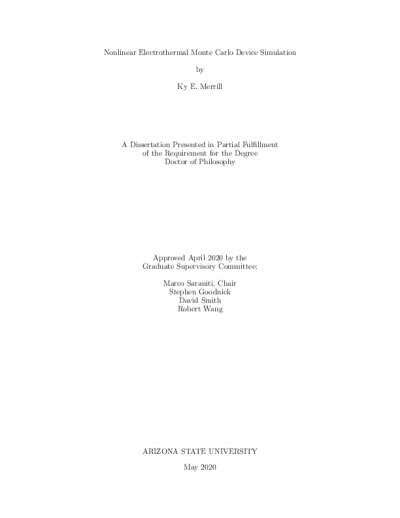
Description
A model of self-heating is incorporated into a Cellular Monte Carlo (CMC) particle-based device simulator through the solution of an energy balance equation (EBE) for phonons. The EBE self-consistently couples charge and heat transport in the simulation through a novel approach to computing the heat generation rate in the device under study. First, the moments of the Boltzmann Transport equation (BTE) are discussed, and subsequently the EBE of for phonons is derived. Subsequently, several tests are performed to verify the applicability and accuracy of a nonlinear iterative method for the solution of the EBE in the presence of convective boundary conditions, as compared to a finite element analysis solver as well as using the Kirchhoff transformation. The coupled electrothermal characterization of a GaN/AlGaN high electron mobility transistor (HEMT) is then performed, and the effects of non-ideal interfaces and boundary conditions are studied.
The proposed thermal model is then applied to a novel $\Pi$-gate architecture which has been suggested to reduce hot electron generation in the device, compared to the conventional T-gate. Additionally, small signal ac simulations are performed for the determination of cutoff frequencies using the thermal model as well.
Finally, further extensions of the CMC algorithm used in this work are discussed, including 1) higher-order moments of the phonon BTE, 2) coupling to phonon Monte Carlo simulations, and 3) application to other large-bandgap, and therefore high-power, materials such as diamond.
The proposed thermal model is then applied to a novel $\Pi$-gate architecture which has been suggested to reduce hot electron generation in the device, compared to the conventional T-gate. Additionally, small signal ac simulations are performed for the determination of cutoff frequencies using the thermal model as well.
Finally, further extensions of the CMC algorithm used in this work are discussed, including 1) higher-order moments of the phonon BTE, 2) coupling to phonon Monte Carlo simulations, and 3) application to other large-bandgap, and therefore high-power, materials such as diamond.
Details
Title
- Nonlinear Electrothermal Monte Carlo Device Simulation
Contributors
- Merrill, Ky (Author)
- Saraniti, Marco (Thesis advisor)
- Goodnick, Stephen (Committee member)
- Smith, David (Committee member)
- Wang, Robert (Committee member)
- Arizona State University (Publisher)
Date Created
The date the item was original created (prior to any relationship with the ASU Digital Repositories.)
2020
Resource Type
Collections this item is in
Note
- Doctoral Dissertation Electrical Engineering 2020
